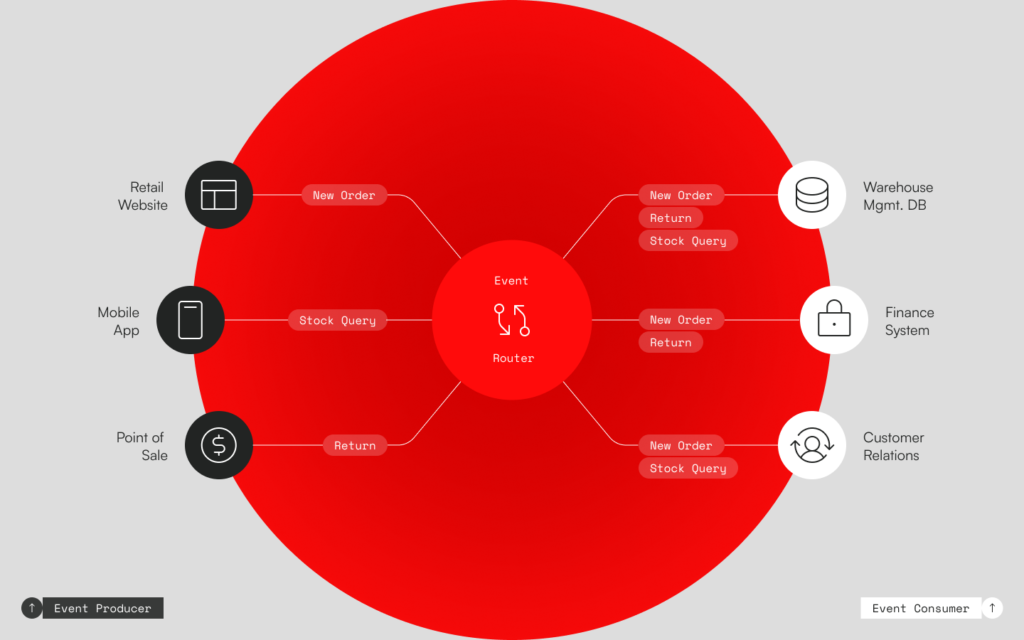Generative AI in Ecommerce: How to Elevate Your Business

If you’re looking for a definitive answer to the question, ‘what is event-driven architecture?’, you’re in the right place. We unmask this critical software architecture paradigm.
Event-driven architecture (EDA).
Although this term was popularized more than a decade ago, it’s being uttered with increased frequency thanks to a surging demand for real-time data.
In fact, a 2021 survey revealed that a mammoth 85% of companies recognised the ‘critical business value’ of adopting EDA.
One industry in which EDA is having a significant impact is ecommerce, creating tangible advantages for related companies.
In this detailed article, we dive into the hot topic of event-driven architecture – breaking down what it is, how it works, its various benefits, and use cases specific to the ecommerce sector.
Based on microservices, EDA is an approach where organizations can detect and respond to an important event.
In e-commerce, an event is defined as any commercial transaction, a site visit, or even adding items to a shopping cart.
The EDA approach is faster than the traditional ‘request-response’ methodology – where services must wait for a response before moving to the next task.
EDA uses a decoupled architecture that can record, transmit, and process multiple events.
Unlike API-based architecture, the EDA approach doesn’t need to share information between services to complete the job.
With APIs, applications must understand the dependencies – and wait for a proper response to their requests.
In EDA, every consumer – or device – processes the events sent to it, while every service can
operate independently in processing events asynchronously.
EDAs have three main components:
Due to the decoupling mechanism, the event producer does not know the event consumer – nor
the outcome of every event.
Imagine a typical online purchase in the e-commerce domain, as demonstrated in the graphic below.
Each time a customer makes a purchase, multiple events are activated, including:
This sounds simple enough. But with increasing competition, e-commerce companies must learn to be more agile and flexible with their responses.
Such agility and flexibility are no longer feasible with monolithic legacy platforms, so EDA provides a timely solution.
This architecture is built to be responsive to multiple events, such as:
Below is an illustration of how the EDA approach works on a typical e-commerce site.
(Add medium graphic)
E-commerce companies can leverage EDA capabilities across multiple applications, or use
cases.
Here are some EDA use cases relevant to this sector:
Each customer order in the e-commerce system represents an event. Based on this event, the customer is immediately notified about receiving the order by the order management system (OMS).
At the same time, an EDA can asynchronously handle the remaining activities of the customer order – such as processing the customer payment and checking if the ordered product is available in the inventory.
The following chart shows how an EDA typically handles events occurring in an OMS.

In the e-commerce domain, customers must always have accurate product-related information across all sales channels. This is where catalog management plays an effective role.
Typically, product catalogs must present accurate information, including product name, description, price, and availability – 24/7 across all channels.
Using EDA, e-commerce companies can decouple and process various events related to catalog management, including:
EDA is a ‘push-based’ architecture that can process events on-demand – as and when the event is presented in the EDA router.
By processing real-time event data, EDAs can help e-commerce companies adjust their product pricing strategy dynamically, based on:
For instance, a consumables company with large quantities of a particular product in its stock can choose to sell it quickly to reduce its warehouse costs. In this case, EDA can be used to perform the following services asynchronously:
An EDA approach offers several significant benefits to e-commerce companies, including the following:
With more e-commerce applications requiring greater flexibility, an EDA’s decoupling can easily separate the event’s producer from the consumer.
This means decoupled components can be effortlessly modified or even removed. For instance, the component handling online payments can be updated without impacting the component that’s sending business emails.
Scalability is another key benefit of EDAs, allowing simple handling of any spikes in workload.
For instance, e-commerce companies can smoothly manage a sudden increase in consumer purchases – without crashing – by creating more event consumers for the added workload.
With this architecture, e-commerce stores can process faster real-time responses to any event.
The applications can immediately act or respond to real-time events, thus providing a faster and more engaging user experience.
Compared to monolithic applications, fault management and problem-solving are more efficient in EDA-powered applications. This is because any failed service will not have a chain reaction on the other services.
This is also beneficial if there is a sudden surge in incoming traffic or workloads.
In the e-commerce domain, consumers are increasingly demanding light-decoupled applications.
It means a rigid architecture is no longer suitable for the fast-evolving e-commerce domain.
With capabilities like decoupling and faster event processing, event-driven architecture is a far superior technology framework for e-commerce stores to adopt.
Clearly, it’s time to embrace the world of EDA.
At RBM Software, we understand the critical need for businesses to adopt an EDA approach – particularly those in the ecommerce sector – and can seamlessly help to make it happen.
Keen to power your business forward fast?
Get in touch.